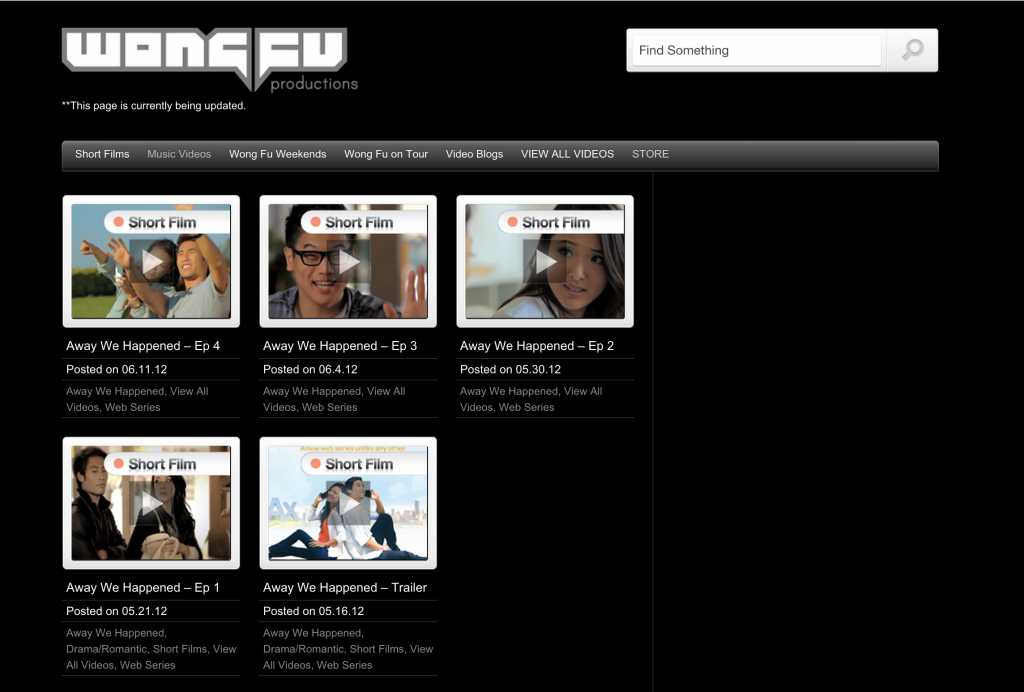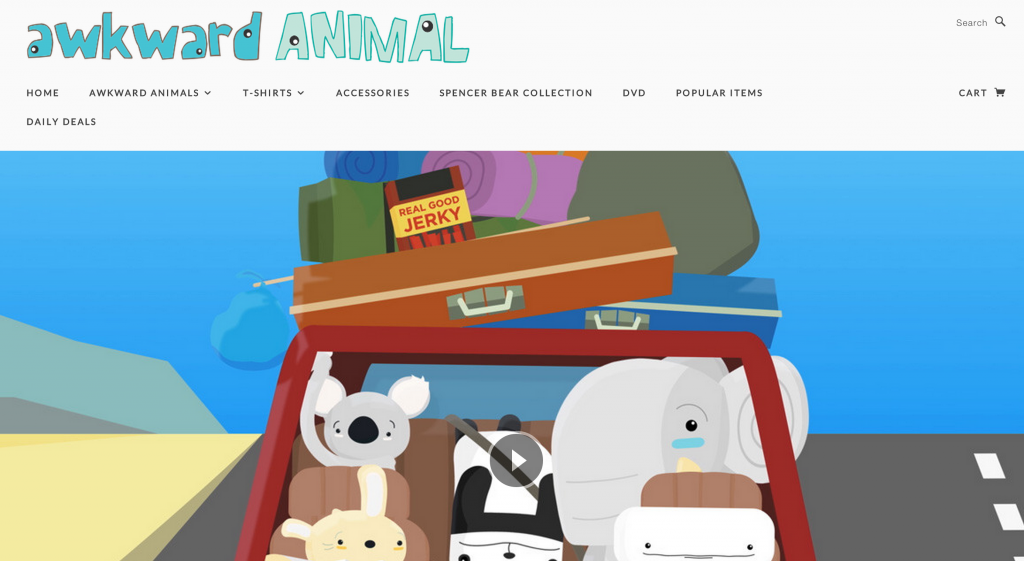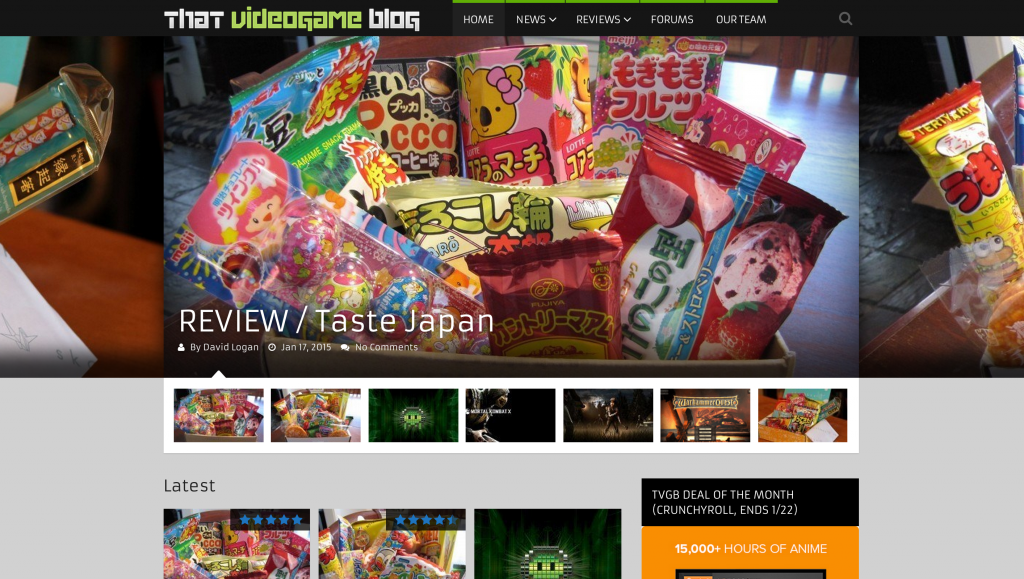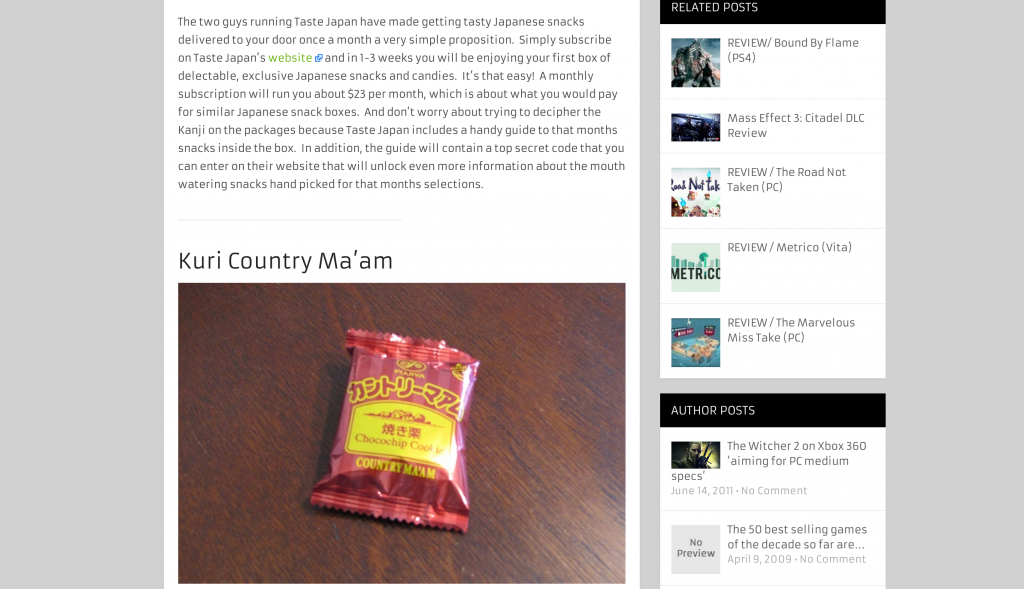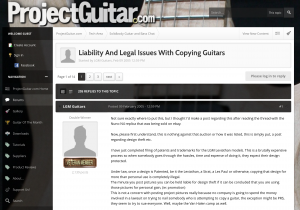Click bait is exactly what it means –baiting you to click on their link for an advertising research.
Category Archives: Uncategorized
To Share
My peers have all written wonderful pieces of blog posts on last week’s classes. Georgina Goodwin had mentioned something intriguing which was seeing Instagram as a blog. A series of photos that captures the memories of your life definitely does have a similarity with blogging. I would call it ‘Photoblogging’! It definitely was a eye-opening perspective on blogging. I have been Instagram-ing for years but I never thought of it as blogging at all.
Another inspiring blog post was Allison Teo’s take on social media. Social media is definitely here to stay. With our ubiquitous screens like smartphones and tablets, social media is easily accessible to us. I can bet majority checks their Facebook or Twitter every morning when they wake up. It’s not to wash up and get ready for the day, it is scrolling through posts on Facebook. It is definitely relatable for people of my generation that social media are taking over our lives. We could possibly not live without social media these days.
A Novel With No Endings?! #goddamncliffhangers
The reading on “The End of Books–Or Books Without End?” by J. Douglas was an interesting piece on how books could go without endings. I was a little skeptical about the readings on having inconclusive pieces because stereotypically speaking, novels must end so that the readers can feel at ease after all the suspense. In relation to ‘Hypertext‘, novels that are inconclusive does give another meaning to hypertexts. Imagine an interactive media where you are able to decide the path of the story and make their own endings. I definitely can refer back to Landow’s Hypertext 3.0 extract on linearity.
The concepts of beginning and ending imply linearity. What happens to them in a form of textuality not governed by linearity? (Landow, p. 110)
Interactive novels were “not govern by linearity”. Landow’s prediction was confirmed by these game books called Fighting Fantasy that chooses your own path by choosing the page you wish your character to head down. These novels jumps pages back and forth as you choose the path for your character. For example, “go through the right door, turn to page 48” or “head down the stairs, turn to page 22” would be the decisions for your character to move. It is interesting how the author had thought and strategically labelled the situations or events. To sidetrack a little, they have it on our tablets and devices now!
Another example is an interactive web series that are up and coming in this modern era. Web series such as WongFu Production’s most recent four episode web series, ‘Away We Happened’ does allow you to choose the path the character goes through by commenting your ideas when they ask “what should she do next?”. (click on the picture to see the trailer)
“One of the purposes driving interactive narratives, however, is the
desire for the inexhaustible story, the mystery that unspools with a
fresh cast of suspects instead of gliding quickly through its denouement
to a limited conclusion; the endless fount of stories that spring
from Scheherazade during her 1,001 nights; the seemingly limitless
versions of long-familiar tales that Homeric rhapsodes spun in
response to cues and demands from their audiences.” (Douglas, J p.13)
After the readings, I realise that why put a stop on our imaginations when you can show an open-ended conclusion for us readers to imagine the endings instead? I felt more inclined to this style due to its unlimited conclusion that you will not run out of conclusion. Arguably, there are still many that disagree with this style. They need closure or their insecurities will take over. Take for example a movie called Inception by Christopher Nolan starring the ever dashing Leonardo DiCaprio! (if you have not watched it, please stop reading and watch it now – shame on you!) The ending of this particular movie has been debated for months even years! Some say he was still trapped in his dream others say he was not. Hence, some people would love to see a resolution than being stuck in suspense wondering the possibilities of the conclusion. In my opinion, it’s a better practice to let your imagination roam wild, the freedom of imagination to think outside of the box.
Don’t get me started on those terribly irritating cliffhangers as well! They really put people at the edge of their seats. I have terrible issues with TV series and anime episodes. However, this causes my mind to run miles thinking on every plausible conclusions. Cliffhangers challenges the mind so we use our brain cells to cough up some possible conclusions for the lead characters. As irritating as it is, I agree with having cliffhangers (all in the video marketing strategy).
This web series Good Mythical Morning discuss about the greatest cliffhangers in TV history:
#goddamncliffhangers
YouTube Feature – WongFu Production
Wong Fu Production – A trio of Chinese Americans who work independently on short films. They are Phillip Wang who is usually the director/producer, Wesley Chan the artist and cinematographer who is always behind the camera (sometimes in front of it as well) and last but not least, Ted Fu who usually does editing and sound operator(has the biggest love for stuffed toys and cats). Their roles are always rotated depending on who writes the script but it’s usually Wesley and Phillip.
Photo Credit: wongfuproductions.com
They started off just doing independent music video and short skits for their university assignments but they ended up really far on YouTube. They created their blog to show their fans their behind the scenes videos, shop for their line of ‘Awkward Animals’ that all their fans absolutely adore (even myself!) and some blog posts on their videos. They connect with the fans with their blogs. Awkward Animals were drawn by Wesley and were produced for their shop.
I look up to this group because I am a budding filmmaker myself, and seeing how far they have come as a YouTuber, they definitely are my source of motivation as a role model. I was hooked when I first saw their collaboration video with a famous Chinese star, Wang Lee Hom for his music video, ‘Yi Ran Ai Ni‘.
Their short skits normally comprises of drama and comedy. Their cinematography is superb, how they have flares and colour tones that varies in each short film. They definitely had the budget to buy their equipment and that shows how far they have come about more than ten years ago.
Just last year they had announced a magnificent thing, that they were making a MOVIE! They finally started achieving their goals since they started. The movie is coming out soon in 2015. Can’t wait!
Starting up your own company with no connections is difficult. YouTube made it easy for us. WongFu started off on YouTube making a name for themselves. It’s amazing how they went from a nobody to somebody in the media industry. I definitely learned that things may seem bleak in the beginning but I am sure with all the hard work put in, I can be as successful as they are one day. My goal was to get into Hollywood and work with the best in the industry but if I were to be a little bit realistic, probably join a local production house and learn the ropes. YouTube is a platform for independent artists and filmmakers out there.
Good Contents of A Blog
Blogs are rated by their contents. Today, my friends and I had a discussion on what makes a blog good. What came up frequently was the contents that are relatable, current affairs and the amount of external links and media contained in each post. Most importantly is whether the contents were related to the readers or current for them to keep coming back for more. Take for example one of the top ten gaming blogs, ‘That Video Game Blog‘ . Due to my love for games, we shall take this blog as an example! I love reading about the latest trend and news for game or technology releases.
The interesting thing about this blog is that they are very organised. They organised their posts with categories and tags. For example, new products are labelled under ‘Feature News’ and reviews and talks about the news under ‘Reviews’ and ‘Editorial’. My favourite section is the Lifestyle section. Not only do they talk about the games featured, they talk about Japan and their famous snacks (as seen in the pictures).
Each post will definitely have an image to give visuals on their posts for the readers to see and videos for further elaboration and entertainment. In short, contents play a big role in what makes the best blog. The media and external links, boost the readers’ knowledge on the specific topic to help them understand better and just for kicks sometimes. These factors help with the ratings and that makes a popular blog.
Food For Thought:
It is a form of trust between the bloggers and the readers. When readers read blogs, they trust the bloggers enough to tell them reliable news. Arguably, there are plenty of hoax and rumours or unconfirmed scandals on the Internet these days. People need to choose whether to believe or not. What happened to all that trust now? One of the recent news of the crash on MH370 was a viral news. The bad side of it is that everyone had their opinions on it but with the collective thinking and facts that have been gathered, which may or may not be accurate, speculated more rumours and false information on the said incident. LiveLeak.com has confirmed that the MH370 hoax was exposed by the video being staged. However, can we even trust this information as well? 
Incidents as big as these events, when the whole world is following on it, tend to get many opinions. These collective facts blurs out the real truth until it is published from the people themselves who were investigating the case. However, people still do not trust all of whatever filtered announcements due to the possibility of a cover up story or something as that.
A question ran through my mind while reading this passage. What happens if the world puts their trust on blogs as their resource for news? People have their freedom to talk and voice out their own opinions but when there are too many opinions, who do we trust then? We cannot always rely on what the media tells us.
Amazon.com, Your Stop for Amazing Online Shopping
When Amazon first launched in 1995 as a website that only sold books, founder Jeff Bezos had a vision for the company’s explosive growth and e-commerce domination.
Amazing enough, Jeff Bezos vision had geared our technology towards e-books. The website grew larger till it was the largest online retailer. Bezos’ vision has definitely been achieved in our time today. The name was chosen to relate to the largest river in the world. To me, it symbolizes the vast amount of item choices that flows into that single domain site. He definitely created that connection right there!
Earlier in class today, it was mentioned that amazon.com relied on users behaviour kind of search style. Their algorithm is influenced by what you prefer and what you like to see. They calculate accordingly to your browsing history. It was an impressive style of algorithm just like how Facebook now uses it to its full potential. Facebook
Major IP Disputes
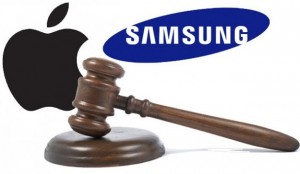
Who were the major parties?
Apple and Samsung were involved in this lawsuit case losing close to a billion US dollars for their series of cases involving patents.
Nature of the dispute:
Apple and Samsung have been taking their patent infringement case to court for years. The cause of it was that Samsung had somewhat copied the originality of Apple’s iPhone. Later on, the Samsung sued Apple for the very same problem as they copied their ‘Lock button’ placement.
What I thought was this fight was slightly unimportant. I feel that patents are overissued, hence these problems arises. I would agree that patenting is a genius idea from getting your ideas stolen or not paying you for it. However, patenting is also slightly malleable as well as a few loop holes in patents. For example, the Gibson guitar was patented for its body style but if another company copies the same body shape but adding extra two more screws, it is not eligible for a sue. The loopholes are definitely big so I wonder, is patenting something quite trivial important enough for a sue? Is it even worth the money and time to bring the case to court?
This website (picture below) tells about another experience on patenting and producing a guitar. Usually a guitar does have a similar body shape. Patenting it seems really useless because the sound of the guitar relies on the body shape.
Creative Commons
What is this Creative Commons? (#caneatoneah?)
Creative Commons was introduced to me not too long ago. What was funny was that I seem to have been breaking the law using pictures illegally before! I might get sued! Thankfully I did not use it for my own profit use or I would be in serious trouble! With the amount of independent artists out there in need to earn their own ways.
Creative Commons has surfaced the digital era for quite a while already and some of us out there still do not understand. I, myself found a few icons related to Creative Commons and it confused me with the amount of combinations listed. The amount of freedom to use the CC licensed work varies with the combination of types of licenses. The picture below shows the different types of combination on how independent artists can license their work gaining freedom or not.
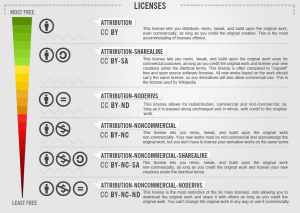
Credits: foter.com
Creative Commons are usually found in media sharing sites such as Flickr and Deviantart. It could be in archival websites as well. Sharing music, images, artwork and videos is shared freely these days and it really does help people who are working independently to display their work easily as others would share or use their work.
Blogging By Bloggers
Blogs are normally (and boringly) known as an online journal or a diary for personal blogs. I personally never took blogging seriously as I do not usually express my opinions by writing. Embarrassing enough, a Y-generation does not use social media to talk about their interests and opinions (even though I have Facebook). Interestingly enough, reading Adrian Miles’ “Blogs in Media Education’ gave me another perspective on blogging. He mentioned the positive outcomes of blogging in our media studies. It definitely does help us, students, in tertiary education to take notes and reflect on the notes. We can even continuously discuss on our opinions and probably questions that arises during classes and research on it more. Instead of just knowing the information, it is written down in your blog to discuss further and understand the different views on a certain key concept. We could even go back to it if another related information arises in the future.
Blog Posting Tutorial
This week we started off by familiarising ourselves with our blogs. We learnt a few tricks on linking other websites, styling our blog appearances as well as posting media. After that, we were given a task, in groups, to write three things you want to attach to your blog but you do not know how to at the moment. We were to pass the list clockwise and try to figure out how to do them and create a tutorial. The list of how to’s:
1) How to add music into the blog.
2) How to attach .gif?
3) How to attach flash games to the posts.
Tutorial:
1) How to add music into the blog?
There are a few ways to do this. One is to embed a playlist from an external link (such as YouTube) and placing it as a post.
 Another way of adding music is to upload mp3 files into your ‘Media Library’ (pic) and then add new post. In the new post, there is a button called ‘Add Media’ and the tab for ‘Create Audio Playlist’ will be visible. Thus, you have your music player as a new post.
Another way of adding music is to upload mp3 files into your ‘Media Library’ (pic) and then add new post. In the new post, there is a button called ‘Add Media’ and the tab for ‘Create Audio Playlist’ will be visible. Thus, you have your music player as a new post.
There was no widget found for music player, only the Podcast from iTunes. So attaching music in new posts is the possible method as for now.
2&3) How to attach .gif files or flash games?
Attaching .gif files is very easy. Once you find a .gif file online, you search for the embed code link, and copy it. Next, open your new post and click on ‘Add Media’ and click on the ‘Insert Embed Code’. Then you have your media attached to your post!
That’s all for this tutorial!




